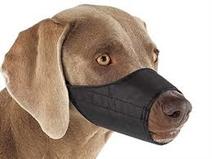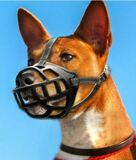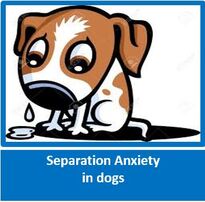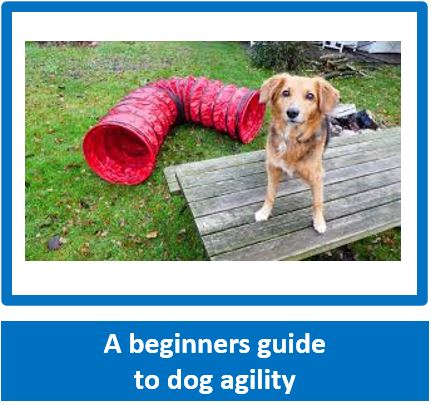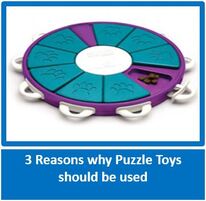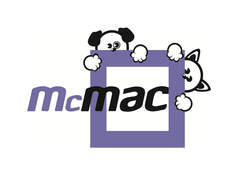
Whether your looking for a muzzle, specialised equipment, top quality pet toys, behaviour games, agility equipment, grooming equipment, bedding and so much more, McMac can help you! You can either buy on-line or purchase from one of our many suppliers. Have a look at our website for what we have available and don't hesitate to contact us if you have any questions. www.mcmac.co.za
Should my pup wear a muzzle?
By Scotty Valadao – Canine Behaviour Consultant - Founder Friends of the Dog
By Scotty Valadao – Canine Behaviour Consultant - Founder Friends of the Dog
.
Although the idea of a cute, cuddly pup wearing a muzzle may sound and look ridiculous, a muzzle really can be a dog’s best friend!
If we look at it from the point of view that during the first 16 odd weeks of a pups life it is so much easier to habituate and desensitize it to all manner of things, why not take advantage of this period and teach your pup how to wear a muzzle? By introducing the muzzle at this early stage you will avoid stress at wearing it when the pup is older, and one thing I can assure you of is that a pup will not be a pup forever!
There is a misconception that only aggressive dogs should wear a muzzle, but this is not entirely true. A dog wearing a muzzle is responsible dog ownership and there are many more situations where a muzzle can come in handy. Here are some of them:-
There are many people that advocate a dog with separation anxiety wearing a muzzle to stop destruction, but I, for one, am not in favour of this. Rather do the rehabilitation work required to put an end to the destructive behaviour and help the dog cope being alone.
In any situation where a muzzle needs to be put on, the dog being used to wearing one will prevent any additional, unnecessary stress for the dog, and that to me is the number one reason for using them.
If we look at the point above where the dog may be reactive or threatening to perceived threats, simply by wearing the muzzle the owner feels that they have control of the situation and the owners stress levels will decrease, thereby lowering the dogs stress levels immediately and allows the owner to control the situation while doing the rehabilitation required.
I am not advocating that a pup or dog walks around all day with a muzzle on, rather that it can be used when necessary, for short periods of time. Under no situation is a muzzle to be used as punishment, rather as prevention and restraint where necessary.
Make sure that the muzzle fits comfortable and the dog is still able to pant, open its mouth etc. There are many different types of muzzles on the market today, and I normally advise clients to make use of two of these – one, the basket muzzle for longer term use, where the dog can easily pant, smell etc and the black, cloth/material one, for use at the vet. If you are going to be using two different types, then practice the exercises below with each muzzle, not just assuming that because the dog is ok with the basket muzzle, he will be ok with the black cloth muzzle.
The following may seem like a lot of work, but I have often had dogs wearing a muzzle happily within an hour. It simply depends on how much work you put in and how your dog copes wearing the muzzle.
How to get your pup used to the muzzle
If you are familiar with TTouch, then start with a lot of Noah’s March and Clouded Leopard around the mouth area, which will relax the dog and make the process easier.
If your pup does not like being touched around the mouth and nose area, then do some work on this first by touching the area, offering a treat until the dog is happy being touched in that area.
1. Start off by having one of your pup’s food allowances in your hand. Allow the pup to smell the muzzle and then pop a treat. Do this repeatedly.
2. When the pup is used to the above exercise, take it one step further by holding the muzzle in your hand close to the nose and a treat in the other hand just at the end of the muzzle opening. This will cause the pup to put its head in the muzzle to retrieve the treat. If the pup is battling with this, then I would suggest using one of the black, material muzzles and opening it up wider and then as the pup accepts this new object, tightening it a bit. Repeat this exercise over and over until the pup is entirely happy and easily putting its nose through the muzzle opening. Make this even more pleasant for the pup by praising him verbally while wearing the muzzle.
3. Next step is to hold the muzzle in place with your hand for a few seconds, then offer a treat at the open end while the muzzle is still on. Again, repeat over and over, very slowly building up the time the muzzle is on the pup’s nose. The treat must be given while the muzzle is in place.
4. Now is the time to have the muzzle in place over the pup’s nose and shut the clasp on the neck. Keep on treating while the muzzle is in place. Do this for short periods of time. One needs to always work with ‘where the dog is at’, as we say in TTouch, being careful never to stress the dog. Working in this manner allows the pup to cope with the new situation without stress and to associate the wearing the muzzle with something pleasant.
5. When your pup is happy wearing the muzzle as above, take him/her out for a short walk, leaving the muzzle loose enough that he can sniff the ground and be offered the occasional treat. The second you come home take the muzzle off. Do this repeatedly and in addition to the pup associating treats with the muzzle, it will start to associate a nice walk as well, further reinforcing the use of the muzzle.
6. Don’t just stop there; wear the muzzle often for walks, for a visit to the vets reception etc, thereby getting your pup used to wearing it in all different types of situation.
7. Please remember that in order for the dog to be really accepting of the use of the muzzle that wearing it needs to be practised on a regular basis.
Problem Solving
If your pup is scratching, rubbing at the muzzle and trying to get it off, you have gone too fast. Simply go back a few steps, taking it slower and start again. Remember that the pup never gets treated while the muzzle is off.
If we look at it from the point of view that during the first 16 odd weeks of a pups life it is so much easier to habituate and desensitize it to all manner of things, why not take advantage of this period and teach your pup how to wear a muzzle? By introducing the muzzle at this early stage you will avoid stress at wearing it when the pup is older, and one thing I can assure you of is that a pup will not be a pup forever!
There is a misconception that only aggressive dogs should wear a muzzle, but this is not entirely true. A dog wearing a muzzle is responsible dog ownership and there are many more situations where a muzzle can come in handy. Here are some of them:-
- In the case of injury, such as being hit by a car, even the best natured dog can try to bite purely out of pain, and the use of a muzzle will safeguard this from happening.
- At the vet when a procedure is to be done that could be painful for the dog. Being used to wearing a muzzle will help the dogs stress levels, plus as both vet and owner will be more relaxed knowing there can be no reactive behaviour, so too will the dog.
- It can be partially used instead of an Elizabethan Collar if your dog has had an operation and is not allowed to lick the area. This is so much more comfortable for the dog than having a large piece of ungainly plastic around its neck and bumping against multiple objects. I normally suggest to clients that when the dog is confined to use the E.Collar and then the basket muzzle for walking around the house. Remember, the muzzle is never left on 24/7.
- If the dog has allergies or similar, it can stop the dog licking the area for periods of time and allow the area to heal. In this situation it can also be used in conjunction with the E Collar above – we all know how difficult it is to stop a dog doing this!
- Even though extensive socialization may have been done, there is often the dog that can’t tolerate children or men for example, and the wearing of a muzzle can prevent any reactive behaviour towards the perceived threat.
- When introducing new dogs or a cat to one another.
- If the dog has an eating disorder such as Corpophagia (eating stools), the muzzle can prevent this happening for short periods while the dog is outside.
- In the case of a dog that is reactive towards other dogs
There are many people that advocate a dog with separation anxiety wearing a muzzle to stop destruction, but I, for one, am not in favour of this. Rather do the rehabilitation work required to put an end to the destructive behaviour and help the dog cope being alone.
In any situation where a muzzle needs to be put on, the dog being used to wearing one will prevent any additional, unnecessary stress for the dog, and that to me is the number one reason for using them.
If we look at the point above where the dog may be reactive or threatening to perceived threats, simply by wearing the muzzle the owner feels that they have control of the situation and the owners stress levels will decrease, thereby lowering the dogs stress levels immediately and allows the owner to control the situation while doing the rehabilitation required.
I am not advocating that a pup or dog walks around all day with a muzzle on, rather that it can be used when necessary, for short periods of time. Under no situation is a muzzle to be used as punishment, rather as prevention and restraint where necessary.
Make sure that the muzzle fits comfortable and the dog is still able to pant, open its mouth etc. There are many different types of muzzles on the market today, and I normally advise clients to make use of two of these – one, the basket muzzle for longer term use, where the dog can easily pant, smell etc and the black, cloth/material one, for use at the vet. If you are going to be using two different types, then practice the exercises below with each muzzle, not just assuming that because the dog is ok with the basket muzzle, he will be ok with the black cloth muzzle.
The following may seem like a lot of work, but I have often had dogs wearing a muzzle happily within an hour. It simply depends on how much work you put in and how your dog copes wearing the muzzle.
How to get your pup used to the muzzle
If you are familiar with TTouch, then start with a lot of Noah’s March and Clouded Leopard around the mouth area, which will relax the dog and make the process easier.
If your pup does not like being touched around the mouth and nose area, then do some work on this first by touching the area, offering a treat until the dog is happy being touched in that area.
1. Start off by having one of your pup’s food allowances in your hand. Allow the pup to smell the muzzle and then pop a treat. Do this repeatedly.
2. When the pup is used to the above exercise, take it one step further by holding the muzzle in your hand close to the nose and a treat in the other hand just at the end of the muzzle opening. This will cause the pup to put its head in the muzzle to retrieve the treat. If the pup is battling with this, then I would suggest using one of the black, material muzzles and opening it up wider and then as the pup accepts this new object, tightening it a bit. Repeat this exercise over and over until the pup is entirely happy and easily putting its nose through the muzzle opening. Make this even more pleasant for the pup by praising him verbally while wearing the muzzle.
3. Next step is to hold the muzzle in place with your hand for a few seconds, then offer a treat at the open end while the muzzle is still on. Again, repeat over and over, very slowly building up the time the muzzle is on the pup’s nose. The treat must be given while the muzzle is in place.
4. Now is the time to have the muzzle in place over the pup’s nose and shut the clasp on the neck. Keep on treating while the muzzle is in place. Do this for short periods of time. One needs to always work with ‘where the dog is at’, as we say in TTouch, being careful never to stress the dog. Working in this manner allows the pup to cope with the new situation without stress and to associate the wearing the muzzle with something pleasant.
5. When your pup is happy wearing the muzzle as above, take him/her out for a short walk, leaving the muzzle loose enough that he can sniff the ground and be offered the occasional treat. The second you come home take the muzzle off. Do this repeatedly and in addition to the pup associating treats with the muzzle, it will start to associate a nice walk as well, further reinforcing the use of the muzzle.
6. Don’t just stop there; wear the muzzle often for walks, for a visit to the vets reception etc, thereby getting your pup used to wearing it in all different types of situation.
7. Please remember that in order for the dog to be really accepting of the use of the muzzle that wearing it needs to be practised on a regular basis.
Problem Solving
If your pup is scratching, rubbing at the muzzle and trying to get it off, you have gone too fast. Simply go back a few steps, taking it slower and start again. Remember that the pup never gets treated while the muzzle is off.

